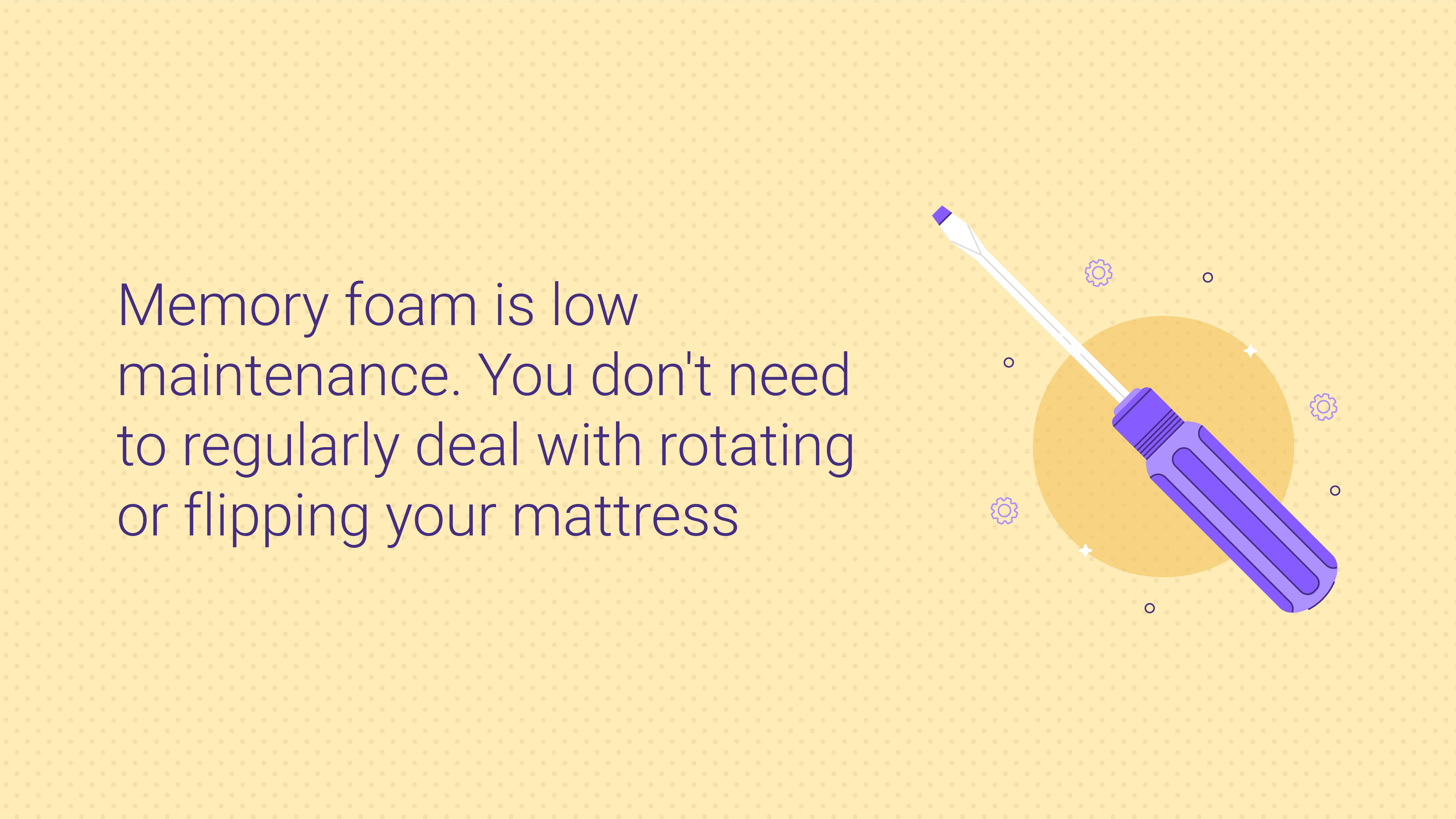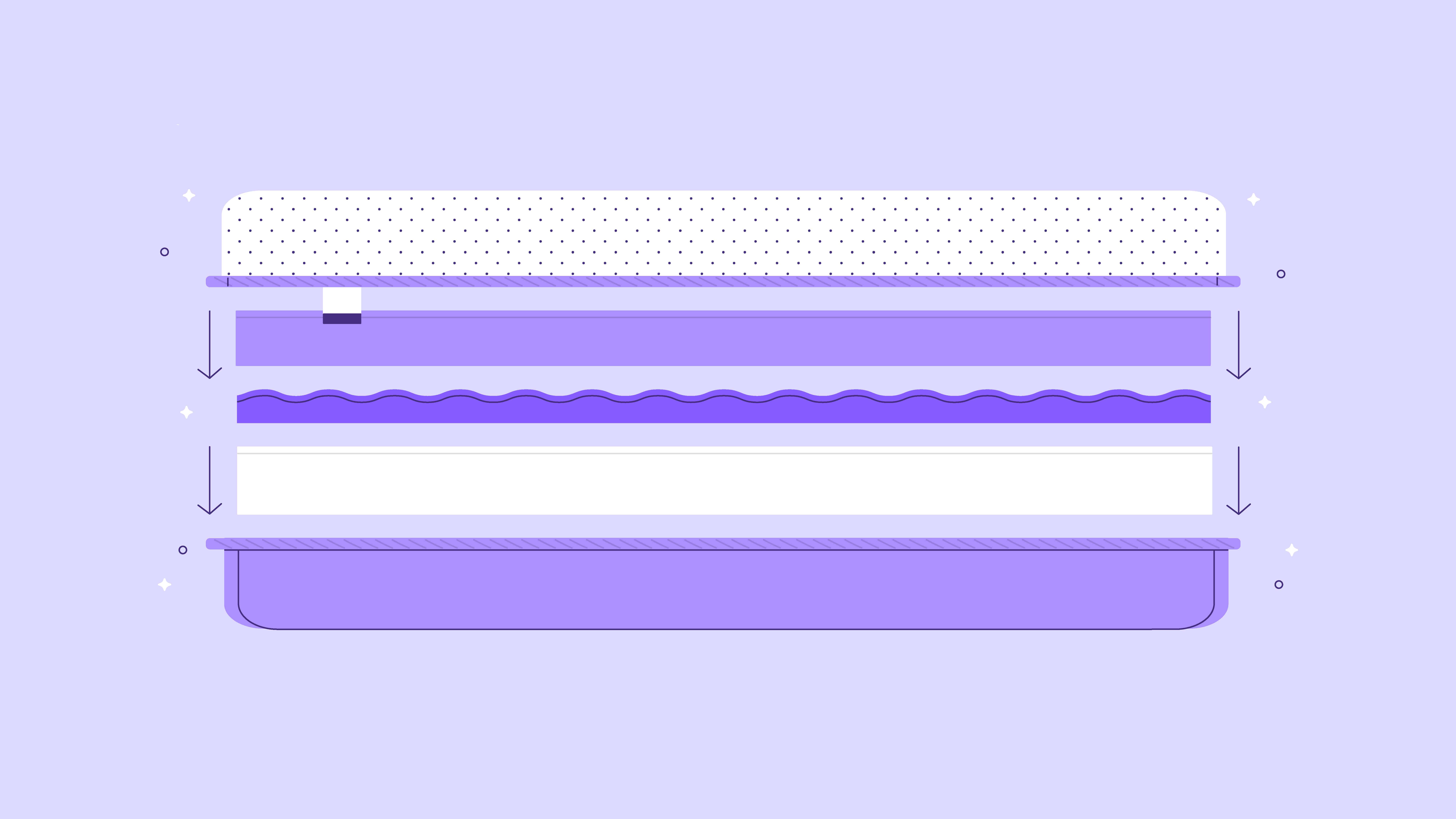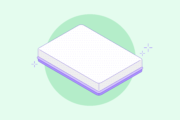What is Memory Foam?

- Memory foam mattresses are renowned for their comfort and durability, providing a high-quality and long-lasting sleep surface. They are considered suitable for all sleep positions, offering support that can alleviate or prevent sleep-related aches and pains.
- Memory foam mattresses are suitable for various sleeping positions. The material’s temperature-sensitive and moldable nature allows it to cradle and support the body, reducing pressure points and promoting proper back and spinal alignment.
- Different types of memory foam, including traditional, gel, and plant-based, offer varying features such as temperature regulation and eco-friendliness, allowing consumers to choose based on their preferences and needs.
So you’re in the market for a new mattress. One that’s high quality, long-lasting, and (of course) supremely comfortable. A memory foam model seems like it might tick all the boxes—everyone you know who has one loves it. But before you dive in for yourself, you want to make sure you’ve got the facts right.
You’ve come to the right place. Memory foam mattresses are known for both their comfort and durability. They’re considered a great option for all sleep positions and can play a role in alleviating or preventing sleep-related aches and pains.
They tend to be a good value and act as some of the best mattresses for the money, too. Memory foam provides durable, resilient comfort and support.
Have more questions? Don’t worry, we’ve got plenty more answers. Here’s a deep dive into everything you might want to know about this mattress type and why it’s worth trying out. Plus, some smart tips for finding the right mattress for you.
In a nutshell, what is memory foam?
Memory foam is a soft, moldable material used for mattresses, mattress toppers, and pillows. Originally designed for NASA, it’s an absorbent, cushiony material called viscoelastic polyurethane foam.
Memory foam is highly responsive. When laying on it, heat and pressure from your body cause the foam to conform to your shape while keeping your body weight evenly distributed. When you get up, the surface goes back to its original shape. Think of it like a mattress that’s been made just for your body—without the crazy price tag of an actual customized mattress.
Memory foam’s moldability is what makes it so comfortable. It’s also why the material can do such a great job at easing or preventing back pain, hip pain, neck pain, or other discomforts. When your mattress fits your body’s unique shape, you’re less prone to pressure points that can disrupt your sleep and leave you sore or achy in the morning.
What are memory foam mattresses made of?
Memory foam itself is made of viscoelastic polyurethane foam. Similar to the foam you get when you wash your hands or your hair, memory foam contains bubbles or cells. This open-cell structure promotes airflow, which allows the material to mold and change shape in response to weight and heat. Some foams also contain natural materials derived from plants like soybeans or castor oil.
What are the overall benefits of memory foam?
Consumers rarely go back after making the jump to memory foam—and for more reasons than you might think. Here’s a look at some of the factors that set memory foam mattresses apart.
- They work for any sleeping position. Memory foam is an ideal fit for back, stomach, or side sleepers. That’s because it’s temperature-sensitive and moldable, so it can cradle and support every part of your body—no matter how you lay down.
- They relieve painful pressure points. Sleeping in the same position for hours can be a recipe for back, hip, or neck discomfort. But the moldability can deliver significant pressure relief to sensitive areas and make for a more comfortable night’s sleep.
- They promote proper back and spinal alignment. The sagging that occurs with traditional innerspring beds can exacerbate pressure points. That’s not the case here. Memory foam distributes weight across your sleep surface evenly, creating a contour for your body’s natural curves. That encourages your back and spine to stay in a neutral, comfortable position.
- There’s no motion transfer. Memory foam absorbs motion instead of spreading it. If your partner shifts positions or gets out of bed, you’re less likely to get woken up.
- They’re hypoallergenic. Memory foam is less prone to accumulating dust mites, which are a top cause of indoor allergies, establishing a hypoallergenic mattress. The foam’s density also does a good job of repelling other common allergens like mold or pet dander.
- They’re a good fit for adjustable beds. Memory foam mattresses easily flex with an adjustable base, so they can contour to different positions without getting worn out. That means sleepers will be comfortably supported laying flat or at an angle.
- They’re low maintenance. Memory foam doesn’t sag or get lumpy, which means you don’t need to deal with rotating or flipping your mattress on a regular basis. (With innerspring models, you’re supposed to do that once a month.)
- They’re more durable. Foam-based beds absorb fewer dust mites and less mold, and they don’t sag. Added together, it’s no big surprise that these mattresses can stay clean and comfortable for a decade or longer.

What does sleeping on memory foam feel like?
Some people compare the surface of memory foam to a cloud. Which sounds nice, of course. But what if you’re looking for a description that’s a little more, well, realistic?
If you’ve spent most of your life sleeping on a traditional innerspring mattress, you’ve probably become accustomed to that bouncy, springy feeling (on a newer mattress) or that saggy, lumpy feeling (on an older, worn-out one).
Foam beds are a little different. When you lay on one, the cells of the foam compress in response to your body’s temperature or weight—so there’s less resistance and pressure than the typical spring bed. The dense, responsive surface has less of a “bouncy” feel and more of a deep cushioning. Some sleepers say laying on memory foam feels sort of like they’re melting or floating.
Are there different types of memory foam?
Different types of foam can contain different materials, which can affect how the bed feels and what your overall sleeping experience will be like. So what exactly sets them apart and what can you expect from each type? Here’s a brief overview.
Traditional memory foam
This is the original type of memory foam, made from petroleum-based viscoelastic foam. Traditional memory foam mattresses are the most common and tend to rate high in customer satisfaction. But there are still some caveats worth knowing about. Traditional foam uses body heat for its moldability, so some people find it warmer and less breathable. And since it’s made entirely from petroleum-based materials, it also emits more volatile organic compounds (VOCs) compared to some other types of foams. That can create odor issues for some customers, especially when a bed is brand new.
Gel memory foam
Gel foams made from traditional foam materials that are mixed or infused with gel beads. Gel absorbs less body heat, so the thinking is that it can create a cooler sleeping experience for those who find traditional foams too warm. But many people who try a gel memory foam mattress find that they’re not as cool as expected. Still, if temperature tends to be a big factor for you, a gel model might be worth trying.
Plant-based memory foam
Plant-derived foams trade a portion of the traditional polyurethane for biologically-based ingredients like soy or castor oil. That makes them a greener option that’s lower in VOCs and less prone to off-gassing. Plant-based beds also use body pressure instead of body heat to contour to a person’s shape, so they tend to offer more breathability and sleep a little cooler. Pressure contouring also makes plant foams a little more responsive, so they’ll adjust more quickly as you change positions.

What’s the lifespan of a memory foam mattress?
Getting a new bed is a big investment, so whatever you decide to purchase, you want to make sure you get your money’s worth for years to come. And when it comes to durability, memory foam options tend to have an edge over other types of mattresses. The lack of coils means foam isn’t prone to developing sagginess or lumps. And it accumulates significantly less dust, dander, and mold.
Are there any downsides to memory foam?
Memory foam offers a lot of advantages over other types of beds. Still, every sleeper has their own unique preferences, and for some people, foam does have a few downsides.
One of the most common issues that tend to come up is heat. Though foam rates high for comfort overall, some sleepers find that the bed simply isn’t cool enough. Some consumers also think that the surface of their bed has a funny chemical smell, especially for the first few weeks after first having the bed delivered.
The good news is that often, these issues can be avoided with a little extra research. Traditional, high-density memory foams are the most susceptible to these kinds of complaints. So if you tend to sleep hot or be sensitive to odors, a plant-based option with a medium- or low-density might be a more comfortable choice. Lower density beds made from plant materials have a more open design than higher-density ones, which gives them more air circulation and greater breathability. So they’re less prone to trapping heat or smells.
Frequently Asked Question
What is the difference between foam and memory foam?
Foam is often used interchangeably with polyurethane foam, or poly-foam. Memory foam is a type of poly-foam, the difference being that it’s processed with chemicals that help it respond to heat and pressure. This allows memory foam to contour closer to your body than traditional poly-foam can.
Do you need a box spring with a memory foam mattress?
No, it’s not a good idea to pair a memory foam mattress with a box spring. The inner coils of a box spring are not spaced close enough together to provide the consistent support that a memory foam mattress needs. This lack of uniform support can let the mattress sink between the coils, causing the mattress to sag prematurely.
Is memory foam bad for your back?
A memory foam mattress can cause back pain if it’s not the best firmness for you. Side sleepers need softer mattresses to relieve pressure in their shoulders and hips. Back and stomach sleepers need firmer mattresses to keep their spines lifted in the neutral position.
Otherwise, memory foam is an excellent mattress for your back. The material is flexible enough to meet the inner and outer curves of your spine.
Are memory foam mattresses good for side sleepers?
Yes, memory foam is an excellent choice for a side sleeper. The material conforms to their body for maximum pressure relief, limiting the chances that they’ll wake up with sore hips and shoulders. Look for a memory foam mattress with a soft to medium feel if you’re a side sleeper.
How long does a memory foam mattress last?
A memory foam mattress tends to last an average of 7 years. Memory foam mattresses made with high-quality materials may last about a decade. If you want a long-lasting memory foam mattress, look for one that’s at least 10 inches thick and contains higher density foams.
How can I find the best memory foam mattress for me?
There’s no single bed that’s perfect for every sleeper. We all have our own ideas about what’s comfortable. And factors like your age, size, weight, and even overall health have an impact on what type of mattress might best suit your needs.
So how can you go about finding the best mattress—or at least a handful of options that might be a good fit? You can never go wrong starting with word of mouth. If you know someone who’s always raving about their memory foam bed, it’s worth finding out more. Don’t have any leads? Impartial review sites like Consumer Reports and Sleep Like The Dead can also be helpful. They often look into granular details that can set mattresses apart, while factoring in things like durability and price.
Another idea: Start your search with online brands. Foam bed manufacturers offer a range of mattress options designed to fit the needs of every sleeper, and have plenty of information about each model to make it easy to find what you’re looking for. Plus, most online brands offer free delivery and a generous at-home trial period. So there’s really nothing to lose—and you’ll save time and energy not having to trek to the big box stores.
And if you’re still not quite sure that memory foam will help you get a good night’s sleep? There’s no need to commit to a brand new bed right away. You can dip your toes into the foam waters by adding a memory foam mattress pad on top of your current bed. Or try swapping out your pillow for a memory foam pillow. If you notice a significant difference, you can take things to the next level by getting a new foam mattress.



